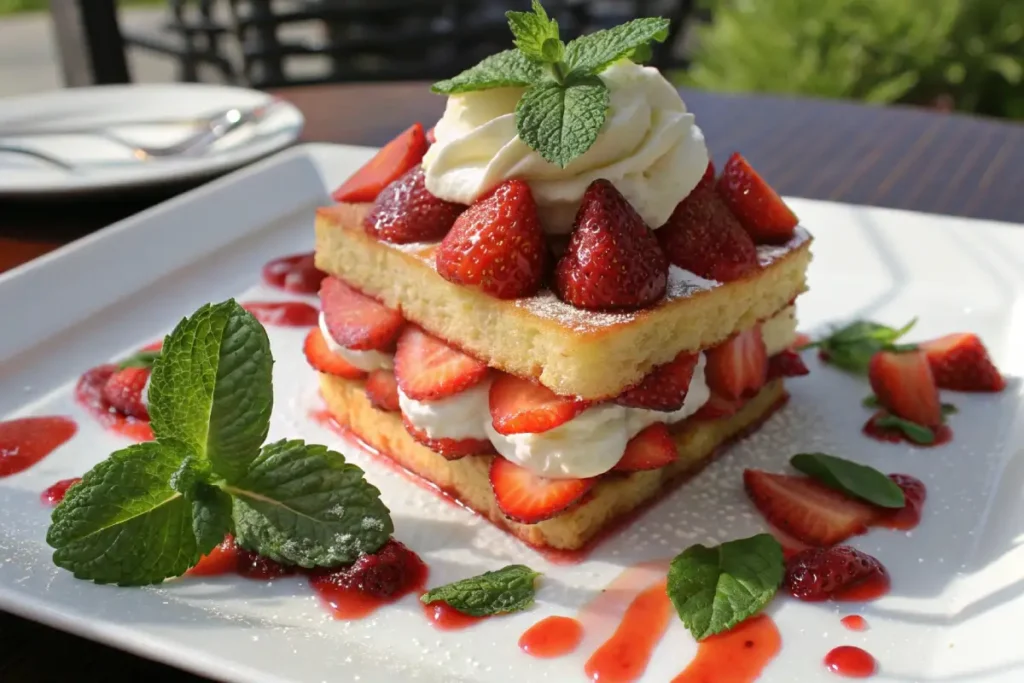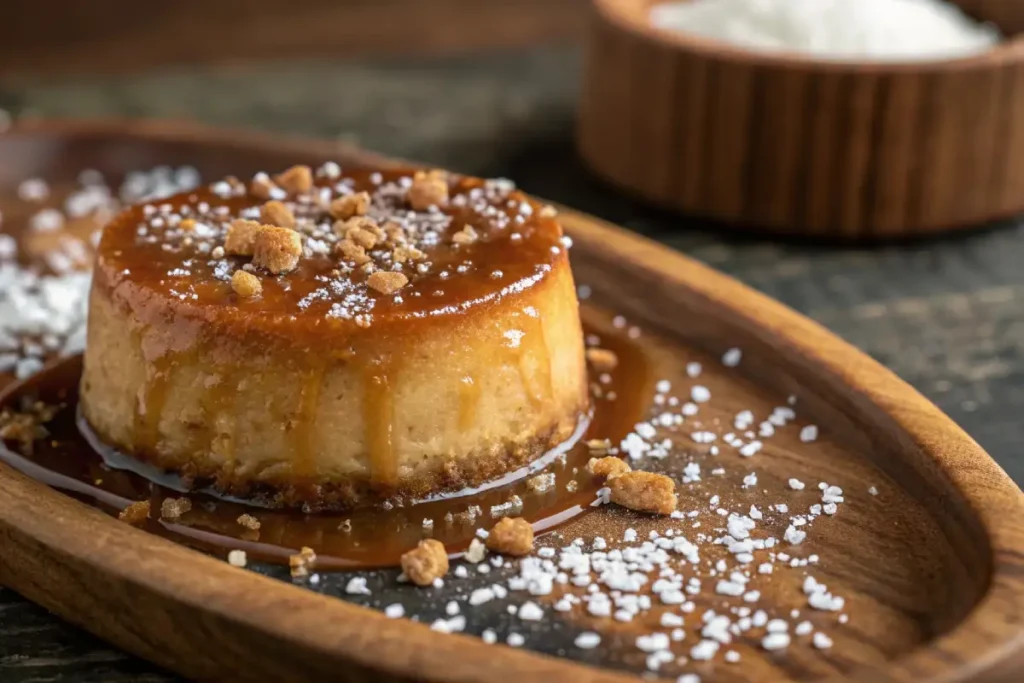Pavé is a luxurious French dessert known for its elegant layers and rich flavors. The term “pavé” translates to “paving stone,” referring to the dessert’s signature rectangular or square shape. Traditionally made with chocolate ganache, sponge cake, or mousse, pavé has evolved into various delicious versions, including fruit-infused and modern gourmet variations.
In this guide, we’ll explore everything about pavé dessert, from its origins and ingredients to step-by-step recipes and expert tips. Whether you’re a seasoned baker or a beginner, this article will help you master the art of making pavé at home.
Table of Contents
What is Pavé Dessert?
The Origins of Pavé
Pavé dessert originates from French patisserie traditions, where refined textures and elegant presentations are highly valued. The dessert gets its name from its rectangular, brick-like shape, similar to cobblestone pavement in France.
Though the classic version is chocolate pavé, variations using fruit, caramel, coffee, or nuts have become increasingly popular. The concept of layering different textures—such as mousse, cake, or ganache—creates a harmonious balance of flavors.
Traditional vs. Modern Pavé Desserts
Over time, pavé desserts have evolved, incorporating innovative ingredients and techniques. Let’s take a closer look at how traditional and modern versions compare:
| Feature | Traditional Pavé | Modern Pavé |
|---|---|---|
| Base Ingredient | Dark chocolate, sponge cake, buttercream | Matcha, caramel, coffee, fruit mousse |
| Layers | Ganache, mousse, or sponge cake | Crunchy nut layers, biscuit base, or fruit purée |
| Sweetness Level | Rich and intense | Can be lighter with fruit or nutty flavors |
| Presentation | Rectangular or square with cocoa dusting | Decorative toppings like gold leaf, berries, or nuts |
Both styles remain popular, with traditional pavé being a favorite for chocolate lovers and modern versions offering a fresh take on the classic.
Why is Pavé So Popular?
Pavé is beloved for its rich texture, elegant presentation, and versatility. It’s perfect for special occasions, dinner parties, or as an indulgent treat. Since it can be made in advance and served chilled, it’s also a convenient yet impressive dessert to prepare.
Classic Chocolate Pavé Recipe
Nothing beats a classic chocolate pavé—a rich, velvety dessert that melts in your mouth. This no-bake French delicacy is easy to prepare and perfect for chocolate lovers. The combination of smooth ganache and delicate layers makes it a crowd-pleaser for any occasion.
Ingredients for Chocolate Pavé
Here’s what you’ll need to make a traditional chocolate pavé:
Base Ingredients
- 200g dark chocolate (70% cocoa or higher) – for a deep, intense flavor
- 200ml heavy cream – to create a silky ganache texture
- 50g unsalted butter – adds richness and smoothness
- 100g sugar – balances the bitterness of dark chocolate
- 1 tsp vanilla extract – enhances the chocolate flavor
- Pinch of sea salt – to elevate the sweetness and depth
For Garnishing (Optional)
- Cocoa powder (for dusting)
- Chocolate shavings or curls
- Berries (strawberries, raspberries)
- Whipped cream
Step-by-Step Instructions
Step 1: Melt the Chocolate
- Chop the dark chocolate into small pieces and place it in a heatproof bowl.
- In a small saucepan, heat the heavy cream over medium heat until it’s hot but not boiling.
- Pour the hot cream over the chopped chocolate and let it sit for 2 minutes.
- Stir gently until the chocolate is fully melted and smooth.
Step 2: Add Butter and Sugar
- While the mixture is still warm, add the butter and stir until fully incorporated.
- Mix in the sugar, vanilla extract, and a pinch of sea salt to enhance the flavors.
Step 3: Assemble the Pavé
- Line a rectangular mold (loaf pan or square baking dish) with parchment paper.
- Pour the chocolate mixture into the mold, smoothing out the top with a spatula.
Step 4: Chill the Pavé
- Cover the mold with plastic wrap and place it in the refrigerator for at least 4 hours, or overnight for best results.
- The pavé should be firm and set before slicing.
Step 5: Serve and Enjoy
- Remove the pavé from the mold and dust the top with cocoa powder for an elegant finish.
- Slice into small rectangular pieces and serve chilled.
- Garnish with fresh berries or chocolate shavings for an extra touch.
Tips for the Perfect Chocolate Pavé
✔ Use high-quality chocolate: Since chocolate is the star ingredient, choose a premium brand with at least 70% cocoa.
✔ Don’t overheat the cream: Too much heat can cause the chocolate to seize and create a grainy texture.
✔ Chill properly: Letting the pavé set overnight ensures the best texture and flavor.
✔ Serve cold: Pavé is best enjoyed straight from the fridge, as it softens at room temperature.
Fruit Pavé Variations
While chocolate pavé is the most well-known, fruit-based pavé desserts offer a lighter and refreshing alternative. These variations replace or complement chocolate with layers of fresh fruit, fruit purées, or mousse, creating a perfect balance of sweetness and acidity.
In this section, we’ll explore some of the most delicious fruit pavé variations, along with a step-by-step recipe for a strawberry pavé—a fruity and creamy twist on the classic dessert.
To explore similar ideas, check out the Dessert Dips for another delightful treat.
Popular Fruit Pavé Flavors
Different fruits work beautifully in pavé recipes. Here are some popular options:
1. Strawberry Pavé
- A combination of vanilla sponge cake, whipped cream, and fresh strawberries.
- Light, refreshing, and perfect for summer.

2. Mango & Passionfruit Pavé
- Uses mango purée and passionfruit mousse for a tropical twist.
- Best served chilled with coconut flakes or white chocolate shavings.
3. Raspberry & Lemon Pavé
- Combines tart raspberry mousse with lemon curd layers for a zesty, tangy flavor.
- Pairs well with a buttery biscuit base or vanilla sponge.
4. Coconut & Pineapple Pavé
- Inspired by piña colada flavors, this pavé blends coconut cream and pineapple chunks.
- Topped with toasted coconut flakes for added texture.
Strawberry Pavé Recipe
This strawberry pavé recipe is creamy, fruity, and incredibly easy to make. It consists of layers of vanilla sponge cake, whipped cream, and fresh strawberries, creating a light and delicious dessert.
Ingredients
For the Pavé Base
- 200g fresh strawberries, sliced
- 200ml heavy cream
- 50g sugar
- 1 tsp vanilla extract
- 200g vanilla sponge cake or ladyfingers
For Garnishing
- Additional strawberry slices
- Powdered sugar
- Mint leaves (optional)
Step-by-Step Instructions
Step 1: Prepare the Whipped Cream
- In a mixing bowl, combine the heavy cream, sugar, and vanilla extract.
- Use a hand mixer or whisk to whip the cream until soft peaks form.
- Set aside in the refrigerator.
Step 2: Assemble the Layers
- Line a rectangular mold or loaf pan with parchment paper.
- Place a layer of vanilla sponge cake or ladyfingers at the bottom.
- Spread a layer of whipped cream over the sponge.
- Add a layer of sliced strawberries, covering the surface.
- Repeat the layering process until the mold is filled, finishing with a layer of whipped cream.
Step 3: Chill the Pavé
- Cover the mold with plastic wrap and refrigerate for at least 4 hours, or overnight for best results.
- The cake layers will absorb the flavors, making the pavé soft and creamy.
Step 4: Serve and Garnish
- Carefully remove the pavé from the mold and slice into rectangular pieces.
- Garnish with fresh strawberries, a dusting of powdered sugar, or mint leaves.
Tips for the Best Fruit Pavé
✔ Use ripe, sweet fruit: The natural sweetness of fresh fruit enhances the flavor without needing extra sugar.
✔ Choose the right base: Sponge cake, ladyfingers, or even graham crackers work well.
✔ Chill properly: A few hours in the fridge helps the layers set and the flavors meld together.
✔ Experiment with flavors: Try mixing fruits like mango & coconut or blueberry & lemon for unique variations.
Tips for the Perfect Pavé
Mastering pavé dessert requires attention to detail, from selecting quality ingredients to achieving the perfect texture. Whether you’re making a classic chocolate pavé or a fruit-based variation, these expert tips will ensure your dessert turns out flawless every time.
1. Choosing the Right Ingredients
✔ Chocolate Selection: If making chocolate pavé, use high-quality dark chocolate (at least 70% cocoa) for a rich, intense flavor. Avoid overly sweet or low-cocoa chocolate.
✔ Fruit Selection: For fruit pavé, choose fresh, ripe fruit for maximum natural sweetness. If using frozen fruit, thaw and drain excess liquid to prevent sogginess.
✔ Cream and Dairy: Always use full-fat heavy cream (at least 35% fat) to achieve a smooth, creamy texture. Lower-fat alternatives may result in a runny consistency.
✔ Sweeteners: If substituting sugar, opt for honey, maple syrup, or coconut sugar for a natural sweetness that complements the dessert’s flavors.
2. How to Achieve the Best Texture
Achieving the right consistency is crucial for a smooth, melt-in-your-mouth pavé.
✔ Melt Chocolate Properly: When melting chocolate for pavé, avoid direct heat—use a double boiler or microwave in short intervals to prevent burning.
✔ Whipping Cream to the Right Consistency: When making mousse or whipped layers, whip the cream to soft peaks—overwhipping can lead to a grainy texture.
✔ Let the Layers Set: Refrigerate for at least 4 hours (ideally overnight) to allow flavors to meld and the structure to firm up.
✔ Prevent Dry Layers: If using sponge cake or ladyfingers, brush with syrup or fruit juice to keep the dessert moist.
3. Presentation & Serving Ideas
Pavé is a visually appealing dessert, and a few simple techniques can make it look even more elegant.
✔ Neat Slicing: Use a sharp, warm knife (run under hot water and wipe dry) to get clean, smooth slices.
✔ Elegant Garnishes:
- Chocolate pavé: Dust with cocoa powder, add chocolate curls, or drizzle with melted chocolate.
- Fruit pavé: Decorate with fresh berries, mint leaves, or a light dusting of powdered sugar.
- Nut-based pavé: Sprinkle with crushed hazelnuts, almonds, or pistachios for added crunch.
✔ Serving Suggestions: Pavé pairs well with espresso, dessert wines (like Port or Sauternes), or a scoop of sorbet for a refreshing contrast.
4. Storage & Make-Ahead Tips
Pavé is an excellent make-ahead dessert since its texture improves after chilling.
✔ How Long Does Pavé Last?
- Refrigerator: Store in an airtight container for up to 5 days.
- Freezer: Wrap tightly in plastic wrap and store for up to 2 months. Thaw in the fridge before serving.
✔ Best Way to Store: If storing multiple pieces, place parchment paper between slices to prevent them from sticking together.
✔ Refrigerate Before Serving: Pavé is best served chilled, as it softens at room temperature. If it becomes too firm, let it sit out for 5–10 minutes before slicing.
5. Common Pavé Mistakes & How to Fix Them
| Problem | Cause | Solution |
|---|---|---|
| Pavé is too soft | Not enough chilling time | Refrigerate for at least 4 hours (preferably overnight). |
| Pavé is too hard | Too much chocolate or overchilled | Let it sit at room temperature for 5–10 minutes before slicing. |
| Ganache is grainy | Chocolate was overheated | Melt chocolate gently using a double boiler. |
| Layers are uneven | Uneven spreading or mixing | Use a spatula to smooth out layers before chilling. |
| Pavé cracks when sliced | Knife is too cold or dry | Warm the knife under hot water before slicing. |
By following these tips, you’ll be able to create a perfect pavé dessert with a smooth, luxurious texture every time.
Unique Pavé Dessert Variations
While classic chocolate pavé and fruit pavé are popular, there are many creative variations that bring new flavors and textures to this elegant dessert. Whether you love coffee, nuts, or exotic ingredients, these unique pavé recipes will impress any dessert lover.
1. Coffee & Hazelnut Pavé – A Rich and Nutty Delight
This pavé is inspired by the flavors of a classic café noisette, combining espresso, hazelnut praline, and chocolate mousse.
✔ Key Ingredients:
- Espresso-soaked sponge cake
- Hazelnut praline cream
- Dark chocolate ganache
- Roasted crushed hazelnuts for texture
✔ Best Garnishes:
- Chocolate-covered coffee beans
- Drizzle of coffee caramel sauce
- A light dusting of cocoa powder
✔ Pairing Tip:
Serve with a shot of espresso or hazelnut liqueur for a gourmet experience.
If you’re looking for a unique twist, consider pairing your dip with Xango Dessert for a soft, lightly sweetened alternative to traditional dippers like graham crackers.
2. Matcha White Chocolate Pavé – A Japanese Twist
For those who love matcha, this pavé balances the earthy, slightly bitter taste of green tea with the sweetness of white chocolate mousse.
✔ Key Ingredients:
- White chocolate ganache
- Matcha-infused sponge cake
- Whipped cream with a hint of vanilla
✔ Best Garnishes:
- A dusting of matcha powder
- White chocolate shavings
- Toasted sesame seeds for an Asian-inspired crunch
✔ Pairing Tip:
Enjoy with a cup of hot matcha tea for a complete experience.
3. Caramel & Sea Salt Pavé – A Sweet and Salty Indulgence
If you love salted caramel, this pavé is a must-try. It features layers of caramel mousse, dark chocolate ganache, and a crunchy biscuit base.
✔ Key Ingredients:
- Salted caramel mousse
- Dark chocolate layer
- Crushed speculoos or shortbread cookie base
✔ Best Garnishes:
- Flaky sea salt on top
- Caramel drizzle
- Gold leaf for an elegant finish
✔ Pairing Tip:
Pair with a glass of Port wine or bourbon to enhance the caramel notes.

4. Coconut & Pineapple Pavé – A Tropical Escape
Inspired by piña colada flavors, this pavé blends creamy coconut mousse with pineapple compote for a refreshing, exotic dessert.
✔ Key Ingredients:
- Coconut cream mousse
- Pineapple purée or jam layer
- Toasted coconut flakes for crunch
✔ Best Garnishes:
- Shredded coconut
- Fresh pineapple slices
- Lime zest for a citrusy kick
✔ Pairing Tip:
Serve with a piña colada or coconut milk latte for a tropical treat.
5. Dark Chocolate & Raspberry Pavé – A Fruity and Decadent Mix
For a tangy yet sweet pavé, this version combines rich dark chocolate with bright raspberry flavors.
✔ Key Ingredients:
- 70% dark chocolate ganache
- Raspberry purée or jam layer
- Almond flour sponge cake
✔ Best Garnishes:
- Fresh raspberries
- Dark chocolate curls
- A drizzle of raspberry coulis
✔ Pairing Tip:
Enjoy with a glass of red wine (such as Pinot Noir) or hot raspberry tea.
6. Pistachio & Honey Pavé – A Mediterranean-Inspired Treat
This pavé is perfect for those who love nutty, aromatic flavors, featuring pistachio mousse and a touch of honey.
✔ Key Ingredients:
- Ground pistachios in the cake base
- Honey-infused mascarpone mousse
- White chocolate glaze for extra sweetness
✔ Best Garnishes:
- Chopped pistachios
- Drizzle of honey
- Edible flowers for decoration
✔ Pairing Tip:
Serve with a cup of chamomile tea or a honey-infused cocktail.
How to Customize Your Pavé
You can mix and match flavors to create your own unique pavé:
✔ Base Options: Sponge cake, ladyfingers, biscuit crust, or nut-based layers.
✔ Mousse Fillings: Chocolate, caramel, vanilla, fruit, or matcha.
✔ Toppings: Cocoa powder, nuts, fruit, edible flowers, or flavored syrups.
The possibilities are endless!
Frequently Asked Questions (FAQs)
What is a pavé dessert?
A pavé dessert is a classic French sweet made with layered ganache, mousse, or sponge cake, often shaped into a rectangular or square block. The name “pavé” means “paving stone” in French, referring to its structured appearance. Chocolate pavé is the most traditional version, but variations include fruit, caramel, or nut-based flavors.
What is a pavé in French food?
In French cuisine, “pavé” refers to any dish shaped like a rectangular block or slab, not just desserts. It can describe a cut of meat, fish, or even cheese that is neatly shaped, similar to a paving stone. In desserts, pavé typically refers to layered cakes or no-bake chocolate confections.
What is a pavé in English food?
In English cuisine, “pavé” is not a widely used term. However, it is often borrowed from French culinary terminology to describe structured, rectangular desserts or neatly cut portions of meat or fish. In desserts, an English equivalent would be layered mousse cakes, no-bake chocolate slabs, or biscuit-based terrines.
What is a pavé?
“Pavé” is a French term meaning “paving stone”, used in culinary contexts to describe square or rectangular-shaped food items. It is commonly associated with French pastries, layered cakes, and even savory dishes like steak or salmon pavé.
Conclusion: Elevate Your Desserts with Pavé
Pavé is more than just a French dessert—it’s a versatile, elegant, and indulgent treat that can be tailored to any taste. Whether you prefer a classic chocolate pavé, a refreshing fruit version, or a modern gourmet twist, this dessert always delivers a luxurious experience.
By following the tips and recipes in this guide, you can confidently create a smooth, melt-in-your-mouth pavé for any occasion. Whether you’re making a vegan, gluten-free, or sugar-free version, or experimenting with matcha, caramel, or nut-based flavors, the possibilities are endless.
So, why not try making pavé at home? With simple ingredients, a little patience, and the right techniques, you can impress your guests (or treat yourself!) with a perfectly chilled, beautifully layered pavé.
Bon appétit!
